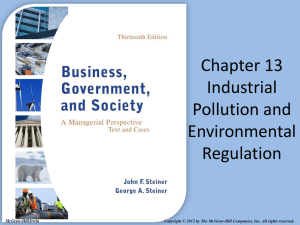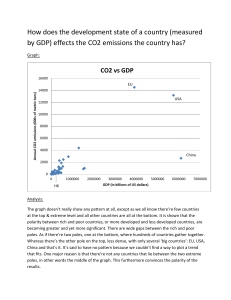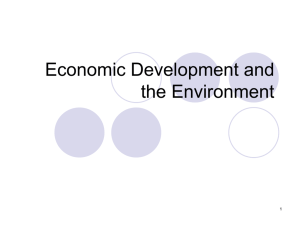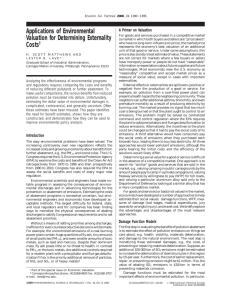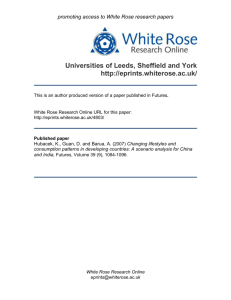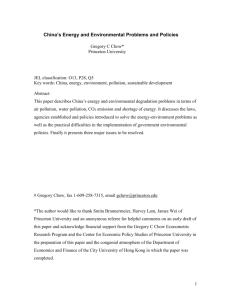B. CO2 Emissions and Economic Development
advertisement
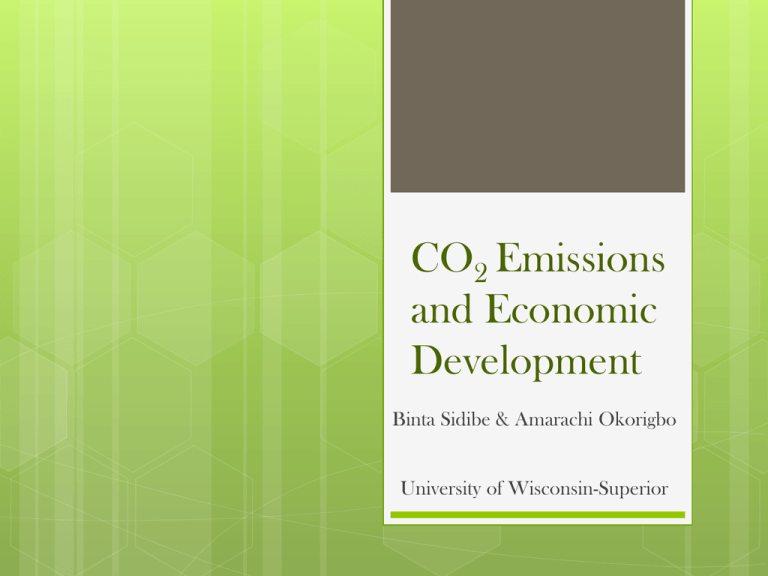
CO2 Emissions and Economic Development Binta Sidibe & Amarachi Okorigbo University of Wisconsin-Superior Introduction • • • • Nations around the world pay high costs for their economic development Human activities cause pollution Pollution is increasing around the world When would development help reduce pollution? Research Questions Is there a relationship between pollution and the level of economic development? If the relationship exists, what functional form characterizes it best? Linear/monotonically increasing Quadratic/concave Theoretical Models of Pollution IPAT Ehrlich and Holdren (1971) Monotonically increasing relationship I= Impact of human activities on the environment P= Population Size A= Affluence, measured here by RGDPPC T= Technology used to produce a unit for consumption Stern (2003) Curve Shifts down over time Grossman and Krueger (1991) Quadratic relationship Early stages of economic development are characterized by degradation and pollution. Turning point where they begin to care more about the environment Pollution Pollution Environmental Kuznets Curve Real GDP per capita Real GDP per capita Measures of Pollution Water and Land Territory-specific Pollution Air pollution Fewer boundaries Negative worldwide externalities of air pollution Main Measure: CO2 Emissions Research Hypotheses 1. There exists a relationship between real GDP per capita and CO2 emissions 2. The relationship between the CO2 emissions and real GDP per capita is quadratic Data: Descriptive Statistics Data: Graph Matrix 5 10 15 -10 -5 0 -20 0 -20 0 5 0 lnco2 -5 -10 15 lnrgdppc 10 5 25 20 lnpop 15 10 0 lncars -5 -10 20 lnforestarea 10 0 0 lncoalrents -20 5 0 lnoilrents -5 -10 0 lngasrents -20 5 0 lnforestrents -5 -10 -10 -5 0 5 10 15 20 25 0 10 20 -10 -5 0 5 -10 -5 0 5 Empirical Model ln(C O 2) it = + 1 lnrgdppc it + 2 lnrgdppc it + 2 3 lnpop it + 4 lncars it + 5 lnfore starea it + 6 lncoalrents it + 7 lnoilren ts it + 8 lngasrents it + 9 lnfore strents it + i + t + e it If hypothesis 1 holds, β1 should be positive and statistically significant If hypothesis 2 holds, β2 should be negative and statistically significant Empirical Model CO2 emissions A B Real GDP pc Empirical Results: Robust LSDV variable constant lnrgdppc lnrgdppc2 lnpop lncars lnforestarea lncoalrents lnoilrents lnforestrents No of obs. R-squared 1 2 3 -12.09*** -18.86*** -16.47*** 1.54*** 1.19*** 2.89*** -0.04*** -0.02 -0.14*** 0.48*** 0.07** 5516 0.9751 5516 0.9756 773 0.998 4 -9.79*** 1.60*** -0.4 5 -11.69* 2.69*** -0.13** -0.28* -0.16 0.04** 0.06 -0.08 588 0.9773 156 0.9908 ***, **, * statistically significant coefficients at 1%, 5%, 10% Analysis of Results There is a statistically significant positive relationship between the CO2 emissions and real GDP per capita The quadratic relationship between CO2 emissions and real GDP per capita is negative and statistically significant in 3 out of 5 regressions While there is evidence to support the Environmental Kuznets Curve theory, such evidence is not robust Analysis of Results: Regression 5 CO2 emissions A B $41,942 $83,884


